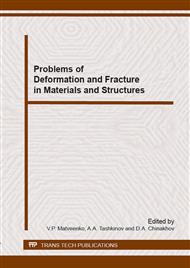[1]
Buryachenko V., Micromechanics of heterogeneous materials, 1st ed., Springer, New York, (2007).
Google Scholar
[2]
Kanouté P., Boso D.P., Chaboche J.L., Schrefler B.A., Multiscale Methods for Composites: A Review, Arch. Comput. Methods. Eng. 16 (2009) 31-75.
DOI: 10.1007/s11831-008-9028-8
Google Scholar
[3]
Torquato S., Random Heterogenous Materials. Microstructure And Macroscopic Properties, Springer-Verlag, (2001).
Google Scholar
[4]
Torquato S., Optimal design of heterogeneous materials, Ann. Rev. of Mat. Research 40 (2010) 101–29.
Google Scholar
[5]
Liu K.C., Ghoshal A., Validity of random microstructures simulation in fiber-reinforced composite materials, Composites Part B: Engineering 57 (2014) 56-70.
DOI: 10.1016/j.compositesb.2013.08.006
Google Scholar
[6]
Liu Yu, Steven Greene M., Chen Wei et al., Computational microstructure characterization and reconstruction for stochastic multiscale material design, Computer-Aided Design 45 (2013) 65-76.
DOI: 10.1016/j.cad.2012.03.007
Google Scholar
[7]
Feng J.W., Li C.F., Cen S., Owen D.R.J., Statistical reconstruction of two-phase random media, Computers and Structures 137 (2014) 78-92.
DOI: 10.1016/j.compstruc.2013.03.019
Google Scholar
[8]
Abdin Y., Lomov S.V., Jain A., van Lenthe G.H., Verpoest I., Geometrical characterization and micro-structural modeling of short steel fiber composites, Composites Part A: Applied Science and Manufacturing 67 (2014) 171-180.
DOI: 10.1016/j.compositesa.2014.08.025
Google Scholar
[9]
Swaminathan S., Ghosh S., Pagano N.J., Statistically equivalent representative volume elements for unidirectional composite microstructures: Part I – without damage, J. Compos. Mater. 40 (2006) 583-604.
DOI: 10.1177/0021998305055273
Google Scholar
[10]
Trias D. et al., A two-scale method for matrix cracking probability in fibre reinforced composites based on a statistical representative volume element, Compos. Sci. Technol. 66 (2006) 1766–77.
DOI: 10.1016/j.compscitech.2005.10.030
Google Scholar
[11]
Romanov V., Lomov S.V., Swolfs Y., Orlova S., Gorbatikh L., Verpoest I., Statistical analysis of real and simulated fibre arrangements in unidirectional composites, Comp. Sci. and Tech. 87 (2013) 126-134.
DOI: 10.1016/j.compscitech.2013.07.030
Google Scholar
[12]
Zeman J., Šejnoha M., Numerical evaluation of effective elastic properties of graphite fiber tow impregnated by polymer matrix, J. Mech. Phys. Solids 49 (2001) 69–90.
DOI: 10.1016/s0022-5096(00)00027-2
Google Scholar
[13]
Hinrichsen E.L., Feder J., Jossang T., Geometry of random sequential adsorption, J. Statist. Phys. 44 (1986) 793-827.
DOI: 10.1007/bf01011908
Google Scholar
[14]
Tashkinov M.A., Wildemann V.E., Mikhailova N.V., Method of successive approximations in stochastic elastic boundary value problem for structurally heterogenous materials, Comp. Mat. Sci. 52 (2012) 101-106.
DOI: 10.1016/j.commatsci.2011.04.025
Google Scholar
[15]
Tashkinov M., Statistical characteristics of structural stochastic stress and strain fields in polydisperse heterogeneous solid media, Comp. Mat. Sci. 94 (2014) 44–50.
DOI: 10.1016/j.commatsci.2014.01.050
Google Scholar


